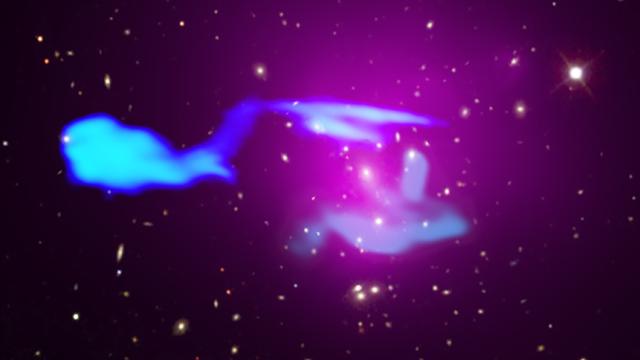Humanity’s current understanding of physics may suggest faster-than-light travel is impossible, but researchers here on Earth can still observe happening in places much too far away to ever actually visit (and generally only what they looked like in the distant past). One of them is a galactic collision that, at least from our planetary vantage point, looks an awful lot like a craft going where no man has ever gone before.
NASA released the above composite image of the galaxy cluster Abell 1033 some 1.62 billion light years away this week, showing wisps of gas that appear to be arranged in the shape of Star Trek‘s USS Enterprise. NASA wrote that the image was captured by the Chandra X-ray Observatory, an X-ray telescope that detects superheated gases, as well as the Low-Frequency Array, which detects radio emissions.
The image might look calm, but it’s the outcome of a cosmic phenomenon releasing incredible amounts of energy. Galaxy clusters are collections of galaxies that are the largest known entities to be held together by gravitational forces, containing both the galaxies themselves and a much larger quantity of superheated gas.
Per NASA, Abell 1033 is actually two galaxy clusters that are in the process of slamming into each other, producing “turbulence and shock waves.” NASA added that the two clusters are interacting with a supermassive black hole, producing jets of high-speed particles that show up as radio emissions:
In Abell 1033, the collision has interacted with another energetic cosmic process — the production of jets of high-speed particles by matter spiralling into a supermassive black hole, in this case one located in a galaxy in one of the clusters. These jets are revealed by radio emission to the left and right sides of the image.
The radio emission is produced by electrons spiralling around magnetic field lines, a process called synchrotron emission.
The electrons in the jets are travelling at very close to the speed of light. As the galaxy and its black hole moved towards the lower part of the image, the jet on the right slowed down as it crashed into hot gas in the other galaxy cluster. The jet on the left did not slow down because it encountered much less hot gas, giving a warped appearance for the jets, rather than the straight line that is typically seen.
NASA added that the radio emissions coming from the cluster would normally lose much of their energy as they radiate, becoming undetectable, though the “vastly extended radio emission observed in Abell 1033, extending over about 500,000 light years, implies that energetic electrons are present in larger quantities and with higher energies than previously thought”:
Other sources of radio emission in the image besides the starship-shaped object are the shorter jets from another galaxy (labelled “short jets”) and a “radio phoenix” consisting of a cloud of electrons that faded in radio emission but was then re-energised when shock waves compressed the cloud. This caused the cloud to once again shine at radio frequencies, as we reported back in 2015.
Researchers with Leiden University, the Institute of Radio Astronomy, the University of Hamburg, and the Max Planck Institute for Astrophysics have published their findings in Science Advances.
[CNET]
